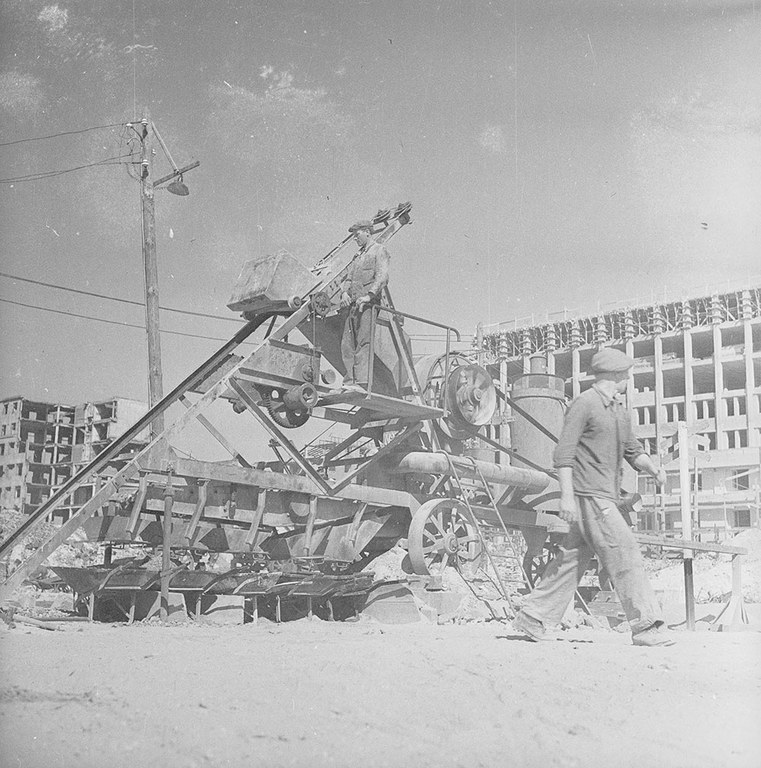Dr. Adam Przywara
Vita
Adam Przywara is an architectural historian and curator. His work investigates environments ruined, or otherwise co-produced by war, and practices of reusing, recycling, and wasting building materials. He studied architectural history at the Bartlett, UCL, and completed his doctorate in architecture at the University of Manchester. Most recently he has completed a postdoctoral project at the University of Fribourg investigating aiding wartime renovations in Ukraine with second-hand windows. Adam was a fellow at the Bauhaus Foundation in Dessau (2018), the German Historical Institute in Warsaw (2020), and a recipient of the Theodor Fischer Award (2024). He curated numerous architectural history exhibitions, most notably 'Rising from Rubble: Warsaw 1945-1949' at the Museum of Warsaw (2023).
______
Adam Przywara about his dissertation „The Materiality of Ruins: Rubble, Salvaged Bricks, and Waste Aggregates in the Postwar Socialist Reconstruction of Warsaw", which was awarded with the Theodor Fischer Award 2024:
 The thesis investigates the materiality of ruins in the postwar history of Warsaw, developing an original approach to nature in architectural history. The resulting account traces the metabolism of ruins unfolding during the reconstruction of Warsaw in the aftermath of World War II. The argument follows the process of material transformation of rubble, i.e., how inhabitants, workers, architects, engineers, and politicians reshaped the ruins left within the city in the wake of German occupation. Simultaneously, it underscores the corresponding process of socialisation of rubble, i.e., how the transformative encounter with postwar ruins shaped the socialist reconstruction effort in the postwar decades. Engaging a wide array of original archival sources, the subsequent chapters show how the architectural profession, the socialist construction industry, and transnational networks of engineering expertise were organised around the practice of building with rubble. Each chapter also demonstrates how the use of rubble fostered a distinct expressivity of architecture and landscape in postwar Warsaw. The resulting narrative introduces rubble, salvaged bricks, and waste aggregates as key materials and historical categories for understanding the postwar socialist reconstruction of Warsaw and the underlying relationship between architecture and nature.
The thesis investigates the materiality of ruins in the postwar history of Warsaw, developing an original approach to nature in architectural history. The resulting account traces the metabolism of ruins unfolding during the reconstruction of Warsaw in the aftermath of World War II. The argument follows the process of material transformation of rubble, i.e., how inhabitants, workers, architects, engineers, and politicians reshaped the ruins left within the city in the wake of German occupation. Simultaneously, it underscores the corresponding process of socialisation of rubble, i.e., how the transformative encounter with postwar ruins shaped the socialist reconstruction effort in the postwar decades. Engaging a wide array of original archival sources, the subsequent chapters show how the architectural profession, the socialist construction industry, and transnational networks of engineering expertise were organised around the practice of building with rubble. Each chapter also demonstrates how the use of rubble fostered a distinct expressivity of architecture and landscape in postwar Warsaw. The resulting narrative introduces rubble, salvaged bricks, and waste aggregates as key materials and historical categories for understanding the postwar socialist reconstruction of Warsaw and the underlying relationship between architecture and nature.
[Caption: Machine processing rubble into fractions, i.e. aggregates and sands, subsequently used for the production of concrete. This machine arrived in Warsaw from Switzerland in the summer of 1947, as a result of the trade agreement between the Polish and Swiss governments. Collection of Military Press Agency, National Digital Archive, Warsaw, Poland]
